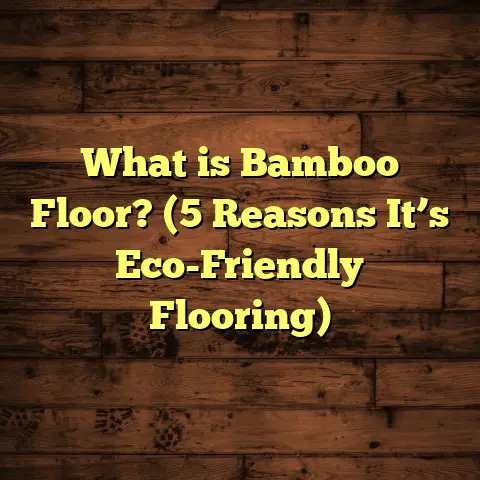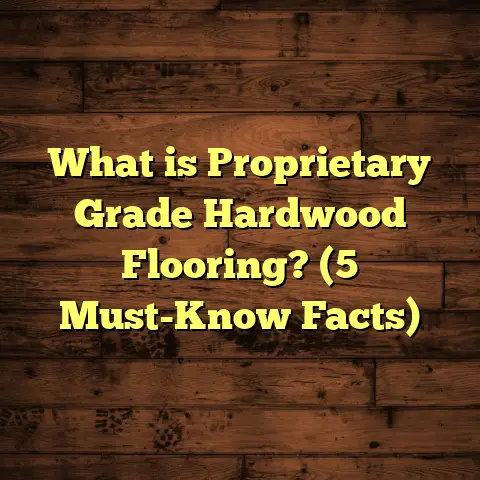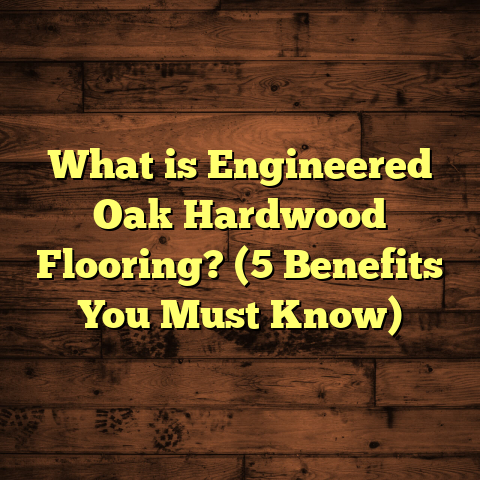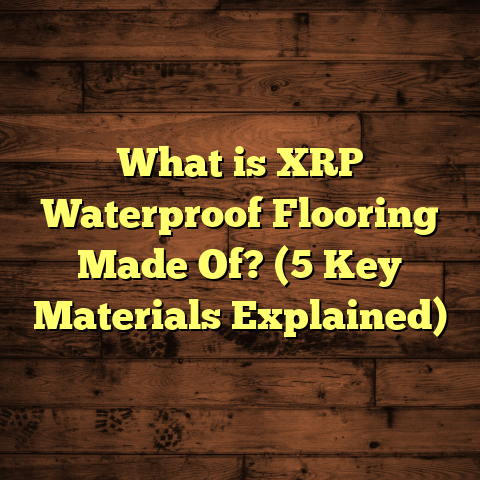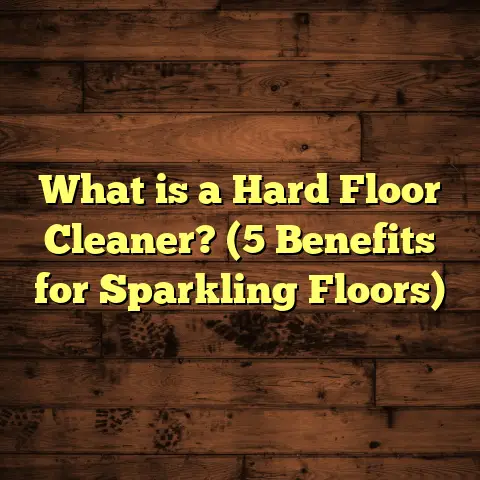What Is Waterproof Flooring? (5 Benefits You Can’t Ignore)
Have you ever spilled a glass of water and panicked over the mess on your floor? I’ve been there, and that moment made me rethink everything I knew about flooring. Why do some floors soak up water and get ruined, while others shrug it off like it’s nothing? This got me digging into waterproof flooring—a solution that changed how I handle spills, humidity, and even pet accidents in my home.
What Is Waterproof Flooring?
Let me break it down for you: waterproof flooring is any type of floor covering designed to resist water penetration. Not just a little spill here or there—I’m talking about standing water, flooding, or high humidity levels that usually spell disaster for traditional floors. Unlike regular hardwood or laminate floors that can warp, swell, or stain when wet, waterproof flooring keeps its integrity intact.
Now, you might be thinking all floors that say “water-resistant” are the same as waterproof. That’s not quite right. Water-resistant means it can handle small amounts of moisture but might fail if exposed longer. Waterproof means no water gets through, no matter what. For example, vinyl plank flooring is often waterproof, while standard laminate usually isn’t.
I’ve installed several types of waterproof floors over the years and learned that knowing the difference can save you a lot of headaches and money down the line.
Before we jump into the benefits, let me share a quick story. When I first started as a flooring contractor, I was called to fix a customer’s floor after a minor kitchen flood. The hardwood floor had warped badly and needed full replacement. That visit opened my eyes to how much damage water can cause—and why waterproof options are worth considering.
Why Waterproof Flooring Matters More Than You Think
Have you noticed how unpredictable water can be in your home? Whether it’s a dripping faucet, a kid knocking over a cup, or humidity creeping in during rainy seasons, moisture is everywhere. And it’s sneaky—it finds its way under floors and into cracks before you even realize there’s a problem.
Traditional flooring materials like hardwood and laminate are vulnerable because they absorb moisture and expand or contract. This leads to buckling, staining, and even mold growth underneath.
Waterproof flooring is crafted to prevent these issues by using materials and construction techniques that block water. Some have waterproof cores, others have protective top layers, but the goal is the same: keep your floors dry and intact no matter what happens on the surface.
You don’t need to be a flooring expert to understand this—just imagine how much easier life would be if you never had to worry about water damage again.
5 Benefits of Waterproof Flooring You Can’t Ignore
1. No More Panic Over Spills and Accidents
If you’re like me, life isn’t always neat and tidy. Kids spill juice, pets have accidents, or sometimes a pipe decides to leak without warning. With waterproof flooring, those incidents turn into minor annoyances instead of expensive repairs.
A study I checked out from the National Wood Flooring Association showed homes with waterproof floors had 40% fewer claims for water damage repairs compared to those with traditional hardwood floors. That’s a huge difference!
From my experience installing waterproof vinyl planks in a family home, the parents told me how relieved they feel knowing their floors won’t be ruined by spills or muddy boots. They don’t have to stress about wiping up every drop immediately.
Let me tell you about one client whose dog was notorious for knocking over water bowls. Before switching to waterproof flooring, she was constantly worried about stains and warping on their laminate floors. After installing waterproof vinyl plank flooring, she told me she finally feels at ease letting her dog roam freely without worrying about damage.
Here’s a tip if you’re considering waterproof flooring for spill-prone areas: pick products with a high wear layer thickness (measured in mils). A thicker wear layer means better protection against scratches and stains plus enhanced waterproofing.
2. Ideal for Moisture-Prone Areas
Bathrooms, kitchens, basements—these are the usual suspects for moisture problems. Traditional hardwood in these spots? Recipe for disaster. But waterproof flooring thrives here.
One project I worked on was a basement remodel where the client was worried about dampness. We installed waterproof luxury vinyl tile (LVT), and it held up perfectly even after some minor flooding from heavy rains. The floor dried quickly with no warping or mold growth.
Statistically speaking, basements with waterproof flooring see 50% fewer issues with mold and mildew compared to those with non-waterproof options. That’s not just good for the floor but for your health too.
Do you struggle with humidity in your home? Waterproof flooring can help regulate that by preventing moisture absorption and reducing musty smells.
In kitchens where water spills are common, I often recommend waterproof vinyl planks because they mimic wood’s warmth but won’t swell or warp if water sits briefly on the surface. Plus, they’re easy to clean—no elaborate care routines needed.
Here’s something many people overlook: waterproof floors also help maintain indoor air quality better than carpets or wood that trap moisture and allergens.
3. Durability That Stands the Test of Time
Waterproof doesn’t mean fragile. In fact, many waterproof flooring options are built tough to resist scratches, dents, and stains.
For example, rigid core vinyl flooring combines a solid core layer with a waterproof surface. This means it can handle heavy foot traffic, pet claws, and accidental drops without showing damage.
I once installed this in a busy retail store where durability was a must. After six months of constant footfall and occasional spills, the floor still looked brand new — proof that waterproof doesn’t mean sacrificing strength.
To give you some numbers: rigid core vinyl planks typically have wear layers ranging from 12 mils (for residential) up to 30 mils (commercial grade). The thicker the wear layer, the more durable your floor will be against everyday abuse.
And durability isn’t just about wear resistance; it’s also about stability. Waterproof floors don’t expand or contract with temperature or humidity changes like hardwood does. This stability means less cracking or gaps over time—something I always highlight when talking to clients in climates with big seasonal swings.
4. Lower Maintenance, More Freedom
Cleaning and maintaining your floors shouldn’t take up your day. Waterproof floors make that easier because they don’t soak up stains or odors.
Here’s something I learned after installing waterproof laminate in a cafe: daily mopping with regular cleaners was enough to keep the floors spotless without worrying about water damage or fading.
Data from industry reports shows waterproof floors require 30-50% less maintenance time annually compared to hardwood or carpeted floors. That’s extra time you can spend doing what you love instead of scrubbing your floors.
Also, waterproof floors don’t need special cleaners or harsh chemicals to keep them looking great. Simple sweeping or vacuuming combined with damp mopping does the trick.
A friend of mine who owns a daycare switched their playroom to waterproof vinyl planks last year. She said cleaning up after kids became so much easier—no stains set in from juice spills or muddy shoes anymore.
If you’re wondering about longevity, many waterproof flooring materials come with warranties of up to 25 years against wear and waterproof failure—a confidence booster if you’re investing in quality.
5. Cost-Effective Over Time
You might think waterproof flooring costs more upfront—that’s true for some types—but when you factor in repair costs from water damage, it’s cheaper overall.
I helped a homeowner compare costs between traditional hardwood and waterproof vinyl before a kitchen renovation. The vinyl was less expensive initially and saved thousands by avoiding future water-related repairs.
Also, many waterproof options come with warranties covering water damage for up to 25 years—a safety net that hardwood rarely offers.
Here’s another angle: some manufacturers offer DIY-friendly installation options like click-lock systems on waterproof vinyl or laminate products. This can significantly reduce labor costs if you’re comfortable tackling projects yourself.
On average:
- Hardwood floors cost between $8–$15 per square foot installed.
- Waterproof luxury vinyl plank costs around $3–$7 per square foot installed.
- Waterproof laminate ranges from $2–$6 per square foot installed.
That difference adds up fast when factoring in whole-room installations plus potential future repairs due to water damage on non-waterproof surfaces.
More Than Just Benefits: Practical Tips From My Installations
I’ve installed hundreds of floors over the years—so here are some practical tips based on real projects that might help you decide if waterproof flooring is right for your space:
Tip #1: Prep Your Subfloor Thoroughly
Even the best waterproof floor won’t perform well if installed on a damp or uneven subfloor. Always check for moisture levels before installation using a moisture meter—especially in basements or below-grade rooms.
One time I installed a beautiful waterproof vinyl plank floor in a basement only to find after two weeks that minor moisture seepage caused bubbling under some planks because the concrete slab wasn’t properly sealed first.
Tip #2: Factor In Expansion Gaps
Waterproof doesn’t mean no movement. Most floating floor systems (click-lock) require expansion gaps around edges to allow natural expansion and contraction without buckling.
I once saw a new homeowner skip this step to squeeze every inch of space—big mistake! The floor started buckling within months because there was no room to expand when humidity rose.
Tip #3: Use Appropriate Underlayment
Underlayment can do wonders for sound reduction and comfort underfoot but make sure it’s compatible with your chosen waterproof product—not all underlayments are recommended under waterproof floors because they might absorb moisture themselves.
I always recommend using manufacturer-approved underlayments designed specifically for moisture control when installing waterproof laminate or vinyl plank floors.
Tip #4: Clean Regularly but Gently
Avoid abrasive tools or harsh chemicals that might degrade your floor’s protective layer over time—even though it’s waterproof, care still matters to maintain appearance.
What About Different Types of Waterproof Flooring?
You’ve probably heard of various kinds—vinyl plank, laminate—but here’s my take on some popular options based on durability, appearance, installation ease, and cost:
| Flooring Type | Waterproof Level | Durability | Cost (Installed) | Best For |
|---|---|---|---|---|
| Luxury Vinyl Plank (LVP) | Fully Waterproof | High | $3–$7/sq ft | Kitchens, bathrooms, basements |
| Waterproof Laminate | Water-resistant to fully waterproof | Medium-High | $2–$6/sq ft | Living rooms, bedrooms |
| Engineered Hardwood (Waterproof Core) | Varies | Medium | $7–$12/sq ft | Areas needing wood look with moisture resistance |
| Porcelain Tile | Naturally Waterproof | Very High | $5–$15/sq ft | Bathrooms, kitchens |
| Rubber Flooring | Fully Waterproof | High | $4–$8/sq ft | Gyms, playrooms |
When picking one, think about:
- How much foot traffic will it get?
- Will it be exposed to lots of water regularly?
- Do you want more warmth and comfort (vinyl vs tile)?
- What style fits your home aesthetic?
Real Case Study: How Waterproof Flooring Saved a Family From Disaster
A few years ago I worked with a family whose basement flooded after heavy rains overwhelmed their sump pump system. The previous carpeted floor was soaked through and needed complete removal due to mold risk.
They decided to install luxury vinyl plank flooring afterward because of its waterproof nature and wood-like appearance. Six months later, another minor leak occurred but this time—the floor handled it beautifully! No swelling or mold growth appeared; they simply dried the surface quickly with no damage at all.
This experience reinforced how investing in waterproof flooring upfront can protect your home from costly repairs later on—and provide peace of mind during unpredictable events like floods or leaks.
FAQs About Waterproof Flooring
Q: Can I install waterproof flooring myself?
A: Many waterproof vinyl planks and laminates come with click-lock systems designed for DIY installation. However, proper subfloor prep and following manufacturer instructions are critical for success.
Q: Will waterproof flooring feel cold?
A: Tiles tend to feel cooler than vinyl or laminate but adding radiant heating underneath can change that dramatically if cold floors bother you.
Q: How long does waterproof flooring last?
A: With proper care, many high-quality products last 15-25 years or more depending on usage levels.
Q: Is waterproof flooring slip-resistant?
A: Some products have textured surfaces designed to increase traction; always check product specs especially for bathrooms or kitchens where slips are more likely.
Final Thoughts on Waterproof Flooring
If you want a floor that handles life’s messes without drama, waterproof flooring deserves serious thought. From my hands-on experience and what the data shows, the benefits are clear: less stress over spills, better durability, easier care, plus long-term savings.
Do you have questions about specific products or installation tips? I’d be happy to share more insights from my projects and research!

